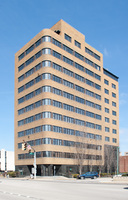
The United Carbon Building is an architecturally significant office building in Charleston that was designed in the streamlined modern style of the 1930s and 1940s. In 1939, Oscar Nelson, president of the United Carbon Company, commissioned Charleston architect Walter F. Martens to design the company’s new headquarters.
Nelson (1879–1953), a Swedish immigrant, had begun as a laborer with the Carbon Black Company in Pennsylvania, which transferred him to a production plant in Grantsville, West Virginia. After rising to superintendent, he resigned to begin his own venture with two wealthy partners from Weston, T. F. Koblegard and Thomas A. Whelan. Under Nelson’s management, the group combined a number of smaller companies in 1925 to form the United Carbon Company. By the 1930s, the company had become the world’s largest producer of carbon black and a major producer of natural gas. United Carbon moved its headquarters to Charleston in the mid-1930s.
Golden brick, black alberene stone, and polished black granite clad the building’s sleek sculptural form, integrating the United Carbon Company’s gold and black trademark colors into the design. Sculptures including the statue of a male figure at the front of the building were designed by Martens’s son, Robert, who at the time attended Michigan’s Cranbrook Academy. The famous Saarinen family of Cranbrook assisted Martens in the project, seeing it as an opportunity to make a statement of their integrated approach to design. The 12th-floor penthouse suite originally had furnishings created at Cranbrook, and above Oscar Nelson’s desk was a wall hanging by Eliel Saarinen’s wife, Loja.
The United Carbon Building’s prominence in its time is signified by its appearance in 1944 on the cover of Pencil Points (later Progressive Architecture, a major architectural magazine), where it was praised as an exemplar of integrated modern design. In 1994, barely 50 years after the building’s completion, it was listed on the National Register of Historic Places. The building was owned by the Nelson family until 1978.
Read the National Register nomination.
This Article was written by Carl Agsten Jr.
Last Revised on June 23, 2022
Related Articles
Sources
United Carbon Building, Charleston, West Virginia. Pencil Points, (Oct. 1944).
United Carbon Builds a Home. West Virginia Review, (Oct. 1940).
Cite This Article
Agsten Jr., Carl "United Carbon Building." e-WV: The West Virginia Encyclopedia. 23 June 2022. Web. 22 October 2024.



Comments?
There aren't any comments for this article yet.
Click here to read and contribute to the discussion →